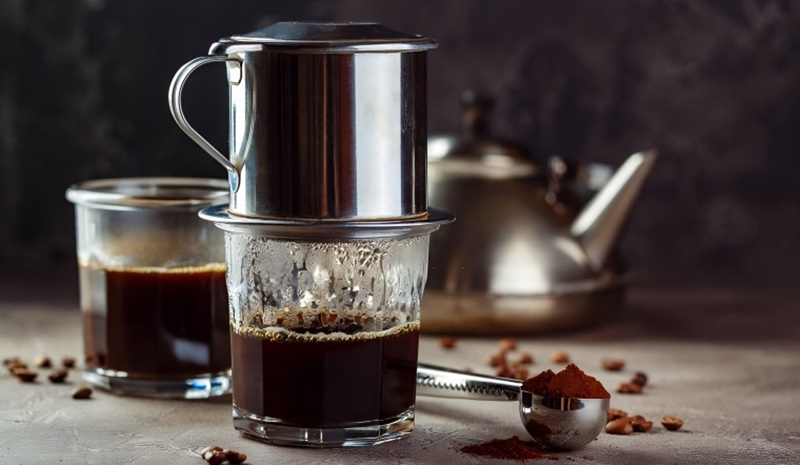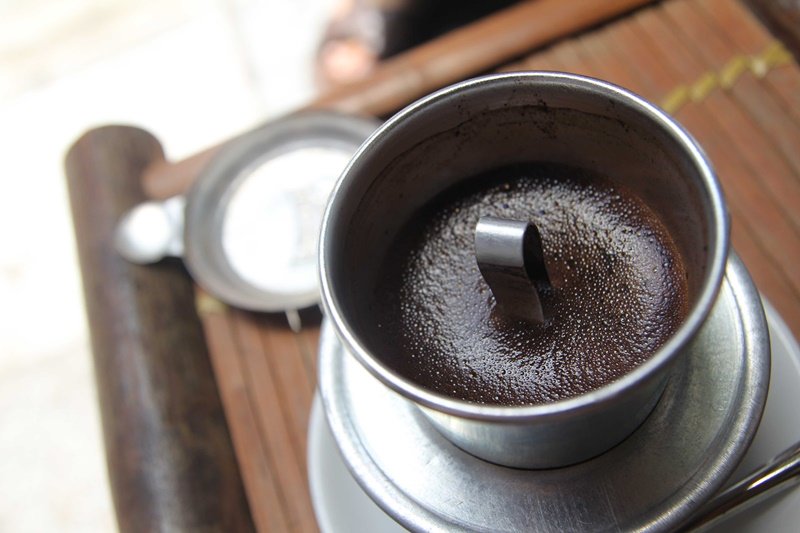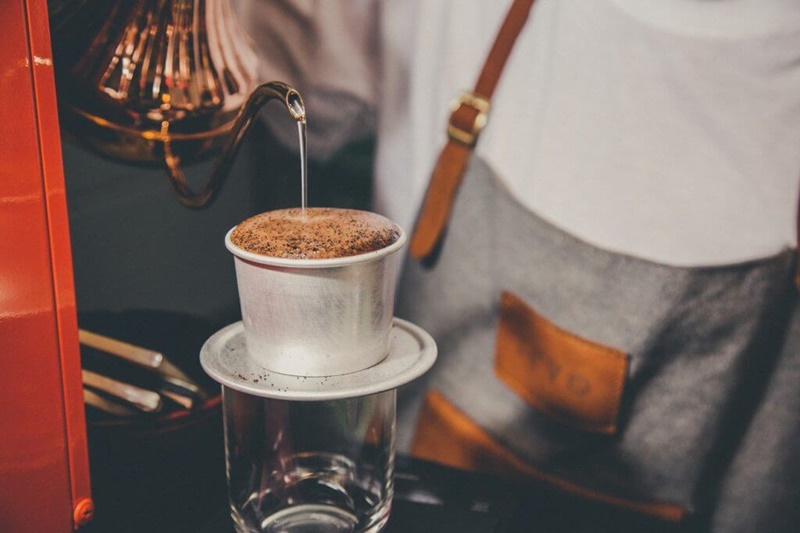What is phin coffee? If you’ve ever delved into the rabbit hole of coffee or traveled to Vietnam, chances are you’ve heard of something like “Phin Coffee”. In fact, this is a beloved brewing method in Vietnam, and Vietnam Adventure will explain it in more detail for you right here.
What is Phin Coffee?
Phin coffee, or aka Vietnamese coffee, is a traditional brewing method in Vietnam that uses a small metal drip filter called a “Phin.” This brewing method is known for producing a rich, robust, and flavorful cup of coffee. If there’s something you don’t like about it, it’s that the method takes a lot of time for a delicious cup of coffee.
So why is it called Phin Coffee? You ask.
Phin Coffee takes its name from the unique tool used in its brewing process – the Phin filter. This traditional Vietnamese coffee press is a small, simple device, usually made of metal. It shares some similarities with a moka pot, but it’s generally much lighter and easier to handle.

What is a Phin filter?
A Phin filter is a small coffee press used to brew traditional Vietnamese coffee. It features four main parts, including a filter plate, a brew chamber, a gravity press, and a cap (or lid).
Filter Plate
This part sits right on top of a cup and allows the coffee to drip very slowly down into the cup below. By the way, you should use a medium-fine grind for optimal results.
Brew Chamber
The brew chamber is the part where the coffee and water will mix together, then resulting in a delicious brew. This is a two-step process:
- The system adds a small amount of water to let the coffee grounds bloom. This is similar to the pre-infusion step in automatic espresso machines.
- Pour in the rest of the water to an under cup with freshly brewed coffee.
Gravity Press
This tool acts like a tamper, and you can use it to press the coffee puck before adding water. You don’t need to press down too hard since the hot water’s pressure will get the job done.
Cap/Lid
The cap or lid helps retain heat during brewing, thus ensuring your coffee is brewed at the perfect temperature.

Pros & Cons of a Phin filter
Let’s explore the pros and cons of using a phin filter to understand why it is very popular.
Pros
- The phin filter is one of the most cost-effective coffee makers available.
- The filter is small and compact, so you can carry it with you easily then enjoy your favorite coffee wherever you go.
- Although it’s traditionally used for robusta coffee, the phin filter works just as well with arabica or liberica beans.
- The phin is built to last. Unlike fragile glass or ceramic brewers, it can withstand daily wear and tear, and any damage can be repaired with simple tools.
- The phin eliminates the need for disposable paper filters since it feature a reusable metal filter
Cons
- It takes 4-6 minutes for a cup of coffee. You should be fine if you just brew a single cup, but making multiple cups can be time-consuming.
- The phin filter typically results in a very strong and bold cup of coffee. While many coffee lovers enjoy this robust flavor, it might be not a cup of tea for those who love a milder coffee.
How to make Phin Coffee
Brewing Vietnamese coffee with a filter is a simple and appealing process. With a little time investment, it will reward you with a heavenly cup of Joe. Here arre all the steps to make this delicious coffee with a standard 4 oz phin filter.
Things To Prepare
- A Phin filter (4 oz)
- Medium-fine ground coffee (Vietnamese coffee is recommended, my choice is Trung Nguyen coffee)
- Hot (but not boil) water
- Condensed milk (if you like)
- Ice (if you prefer iced coffee)
- A cup
Step-by-step Guide
Step 1: Bring water to hot but just below boiling, around between 195 and 205°F (90-96°C).
Step 2: Grind your coffee beans to a medium-fine consistency, and you should use Vietnamese coffee for the most authentic flavor as mentioned above.
Step 3: Place your mug right under the phin filter.
Step 4: Put 2 tablespoons of coffee grounds into the brew chamber of the phin filter.
Step 5: Use the gravity press to press the coffee grounds lightly and evenly.
Step 6: Pour in just enough hot water to cover the coffee grounds, then let it bloom for about 30-60 seconds. That way, the coffee grounds can release gases for the best flavor.
Step 7: Pour the remaining hot water into the phin filter until it is nearly full.
Step 8: Allow the coffee to drip slowly into the mug, which should take about 4-6 minutes. This takes a bit long, but you will have a strong, full-bodied coffee.
Step 9: Once the dripping stops, your coffee is ready to sip. Then, you can add 1-2 tablespoons of condensed milk to the brewed coffee and stir if you like. For a cup of iced coffee, just pour it over a glass filled with ice.

What is the Best Coffee Bean for Phin Filter?
Robusta beans are preferred for a true Vietnamese coffee experience. They provide a strong, bold flavor with a higher caffeine content, which is characteristic of traditional Vietnamese coffee.
Still, you can also experiment with liberica or arabica beans. Arabica beans will offer a smoother, more nuanced flavor, while liberica beans can add a unique fruity or floral note to your cup of Joe.
By the way, a medium-fine grind is ideal for Phin coffee. Too coarse a grind will result in a weak and underwhelming brew, while too fine a grind can lead to over-extraction and clogging.
The Bottom Line
By now, you should know what is Phin Coffee. This is freshly brewed Vietnamese coffee with a rich, robust and deep flavors. If you’ve added condensed milk, it will have a delightful sweet and creamy touch. Take a shot now!

 Ms.Katie
Ms.Katie